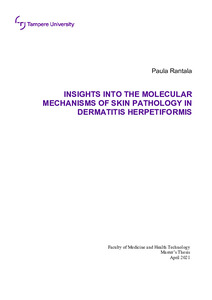Insights into the molecular mechanisms of skin pathology in Dermatitis herpetiformis
Rantala, Paula (2021)
Rantala, Paula
2021
Master's Programme in Biomedical Technology
Lääketieteen ja terveysteknologian tiedekunta - Faculty of Medicine and Health Technology
This publication is copyrighted. You may download, display and print it for Your own personal use. Commercial use is prohibited.
Hyväksymispäivämäärä
2021-05-06
Julkaisun pysyvä osoite on
https://urn.fi/URN:NBN:fi:tuni-202104233341
https://urn.fi/URN:NBN:fi:tuni-202104233341
Tiivistelmä
Dermatitis herpetiformis (DH) is a skin-related manifestation of celiac disease, in which dietary gluten causes itching and blistering rash, especially in the elbows, knees and buttocks. Therefore, the treatment is a strict gluten-free diet. DH is characterized by granular immunoglobulin A (IgA) deposits found in the upper dermis of the skin. The main antigen of these IgA autoantibodies is epidermal transglutaminase (TG3), which is normally present in the keratinocyte layer of epidermis, but not in the dermal-epidermal junction where it accumulates complexed with the IgA in the case of DH. Although many factors, including strong genetic background involved in the pathogenesis of DH has been identified, the details of the molecular mechanisms by which these factors end up affecting the skin, are unknown. The aim of this thesis is to identify if certain structural proteins in the skin attract IgA and TG3 into the dermal papillae and further cause the development of the symptoms. In addition, the mechanism of blister formation, i.e., skin layer separation, particularly the potential involvement of neutrophils is assessed.
Indirect immunofluorescence method was used for observing colocalization of the TG3-IgA complexes and selected structural proteins of the skin. Frozen skin biopsy sections of DH patients were stained with antibodies against TG3, IgA and structural proteins: type IV collagen, type VII collagen and fibrinogen and the colocalization between TG3 and others were visualized with labelled secondary antibodies and fluorescence microscopy. Further, in order to confirm if circulating TG3-IgA immunocomplexes in DH patient’s serum interacts with fibrinogen, fibrinogen protein was western blotted separately in native and denatured forms. Isolated fibrinogen membranes were treated with DH patient’s serum and IgA was observed by immunofluorescence. For neutrophil treatment of the skin biopsies, samples were activated with DH patient’s serum and incubated with isolated granulocyte solution.
First, the immunofluorescence results showed that TG3 colocalizes with IgA and fibrinogen. To the contrary collagen IV and collagen VII were seen to localize separate from TG3. Secondly, fibrinogen protein immunoblots did not show binding between isolated fibrinogen and DH patient serum derived IgA. Finally, no visible difference in dermal-epidermal junction was seen between control and granulocyte treated skin section samples.
To conclude, this study supports the evidence that fibrinogen might play a part in pathogenesis of DH with TG3. Also based on the findings of this study, two subtypes of collagen proteins, type IV and type VII can be convincingly excluded as potential interaction partners for TG3 in the dermal-epidermal junction. Lastly, at least the methods used in this thesis were not able to demonstrate IgA and fibrinogen interaction nor neutrophil driven skin layer separation in vitro.
Indirect immunofluorescence method was used for observing colocalization of the TG3-IgA complexes and selected structural proteins of the skin. Frozen skin biopsy sections of DH patients were stained with antibodies against TG3, IgA and structural proteins: type IV collagen, type VII collagen and fibrinogen and the colocalization between TG3 and others were visualized with labelled secondary antibodies and fluorescence microscopy. Further, in order to confirm if circulating TG3-IgA immunocomplexes in DH patient’s serum interacts with fibrinogen, fibrinogen protein was western blotted separately in native and denatured forms. Isolated fibrinogen membranes were treated with DH patient’s serum and IgA was observed by immunofluorescence. For neutrophil treatment of the skin biopsies, samples were activated with DH patient’s serum and incubated with isolated granulocyte solution.
First, the immunofluorescence results showed that TG3 colocalizes with IgA and fibrinogen. To the contrary collagen IV and collagen VII were seen to localize separate from TG3. Secondly, fibrinogen protein immunoblots did not show binding between isolated fibrinogen and DH patient serum derived IgA. Finally, no visible difference in dermal-epidermal junction was seen between control and granulocyte treated skin section samples.
To conclude, this study supports the evidence that fibrinogen might play a part in pathogenesis of DH with TG3. Also based on the findings of this study, two subtypes of collagen proteins, type IV and type VII can be convincingly excluded as potential interaction partners for TG3 in the dermal-epidermal junction. Lastly, at least the methods used in this thesis were not able to demonstrate IgA and fibrinogen interaction nor neutrophil driven skin layer separation in vitro.
